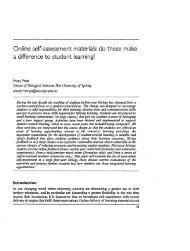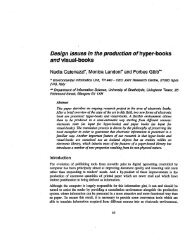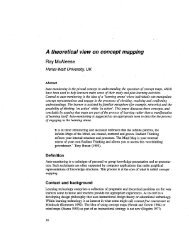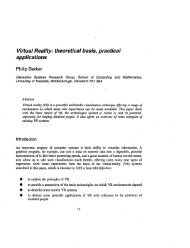Download (2177Kb) - ALT Open Access Repository - Association for ...
Download (2177Kb) - ALT Open Access Repository - Association for ...
Download (2177Kb) - ALT Open Access Repository - Association for ...
Create successful ePaper yourself
Turn your PDF publications into a flip-book with our unique Google optimized e-Paper software.
0038 SP: Collaborative Tchnology<br />
Implementing and trialling an award-winning<br />
mobile phone interface to the Sakai VLE<br />
Authors<br />
Adam Marshall<br />
Fawei Geng<br />
Jill Fresen<br />
Theme<br />
Broad tents and strange<br />
bedfellows<br />
Tags<br />
authentication, classroomVoting,<br />
collaboration, handheldDevices,<br />
mobileLearning, openSource,<br />
Sakai, sharedServices, VLE<br />
In recent years, mobile devices have begun to be used more and more to<br />
access learning resources and this trend is set to continue (Educause, 2009);<br />
evidence suggests that mobile devices maximise productive learning time<br />
(Motiwalla, 2007) and facilitate access to institutional services including<br />
VLEs (Educause, 2009).<br />
The University of Ox<strong>for</strong>d uses the open source Sakai as its institutional VLE.<br />
JISC funding was secured in 2009 and an award-winning (UCISA, 2011)<br />
mobile portal (“Mobile Ox<strong>for</strong>d”) was developed incorporating an interface<br />
to certain tools within Sakai. The intention was not to provide a mini<br />
version of Sakai but instead to offer something familiar to users of various<br />
phone applications (“apps”) and concentrate on the tasks that work well<br />
on a phone. The tools targeted to be enabled via the mobile plat<strong>for</strong>m are:<br />
Polls, Tutorial Sign-up, Resources (documents, images etc.), Surveys and<br />
Announcements.<br />
The approach adopted was to develop a mobile plat<strong>for</strong>m which relays<br />
requests from a browser running on a smart phone to the VLE. When<br />
queried, the VLE sends in<strong>for</strong>mation back to the mobile plat<strong>for</strong>m, which then<br />
constructs a web page and <strong>for</strong>wards it to the user’s phone in an optimal<br />
<strong>for</strong>mat.<br />
One of the biggest challenges was authentication: users should not have<br />
to authenticate every time they wish to access Sakai – we opted <strong>for</strong> oAuth<br />
which is a system used by Flickr amongst others. The idea is that after a<br />
single ‘normal’ login, a user’s phone will be able to access the VLE <strong>for</strong> a<br />
year without further authentication; we manage the security implications by<br />
granting reduced access to tools in the VLE.<br />
During the academic year 2010/11, we ran a pilot project which attracted 101<br />
staff users to the support site in the VLE. Lunch-time sessions were held to<br />
demonstrate the interface and outline the pedagogical possibilities of mobile<br />
access. We will report on a case study in Medical Sciences in which students<br />
worked collaboratively and used their phones synchronously to respond to a<br />
set of revision questions presented using the Polls tool.<br />
References<br />
Educause. 2009. The ECAR study of undergraduate students and in<strong>for</strong>mation technology (ID:<br />
ERS0906).<br />
Motiwalla, L.F. 2007. Mobile learning: A framework and evaluation. Computers & Education 49(3):<br />
581–596.<br />
UCISA. 2011. University of Ox<strong>for</strong>d wins the Award <strong>for</strong> Excellence. www.ucisa.ac.uk/en/news/2011-02-<br />
01-afe-winner.aspx.<br />
27







